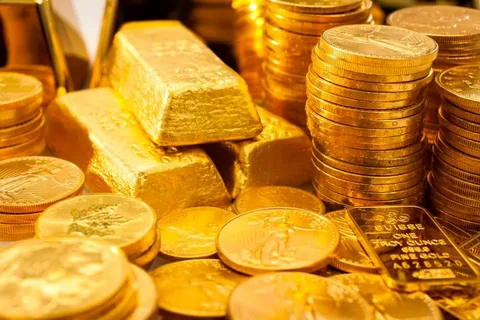The price of gold has long been a key indicator of economic stability and market uncertainty. Analysts have been closely monitoring the fluctuations in the gold market, and their forecasts suggest that volatility is expected to persist. With global uncertainties such as geopolitical tensions and the ongoing pandemic, the price of gold is expected to continue experiencing fluctuations. In this article, we will delve into the predictions of analysts and explore the factors driving the volatility in the gold market.
The gold price forecast is marked by analysts predicting volatility as market uncertainty persists. The ongoing economic and geopolitical uncertainties have contributed to fluctuating gold prices, with analysts unable to provide a clear and stable forecast. The unpredictability of global events, such as the US-China trade war and Brexit, has led to increased market volatility, making it difficult to confidently predict gold prices in the near future. As a result, traders and investors are advised to closely monitor market trends and news developments to stay informed about potential shifts in the gold market.
The Fluctuating Economy: Understanding the Price of Gold

The price of gold is influenced by various factors including supply and demand, inflation rates, interest rates, and economic stability. As a physical commodity, gold is also affected by geopolitical and global economic events. Investors often turn to gold as a safe haven during times of economic uncertainty, which can drive up its price. Additionally, central banks and government policies can impact the price of gold. Understanding these factors can help in predicting and navigating the fluctuating economy and the price of gold.
Investing in Uncertain Times: The Role of Gold Prices

Investing in uncertain times can be challenging, and gold prices often play a significant role in investors’ decisions during these periods. Gold is considered a safe-haven asset, meaning that it tends to retain or increase its value during times of economic or geopolitical turmoil. This makes it an attractive option for investors looking to hedge against market volatility and protect their wealth.
During uncertain times, such as economic downturns or political instability, investors may turn to gold as a store of value and a potential safe haven. This can lead to an increase in demand for gold, driving up its price. As a result, investing in gold can provide a level of stability and security to an investment portfolio during uncertain times.
However, it’s important to note that investing in gold also comes with its own risks and considerations. Gold prices can be influenced by various factors, including interest rates, inflation, and currency movements. Additionally, the price of gold can be volatile, and it may not always move in the opposite direction of other assets, such as stocks or bonds.
Overall, gold can play a valuable role in a diversified investment strategy, particularly during uncertain times. However, investors should carefully consider their investment objectives, risk tolerance, and the overall market environment before making any investment decisions related to gold.
The Impact of Global Events on Gold Price Trends

The impact of global events on gold price trends is significant and widely documented. Gold is often seen as a safe-haven asset during times of political, economic, and social uncertainty. Events such as geopolitical tensions, natural disasters, and economic crises can cause investors to flock to gold as a store of value, leading to an increase in demand and subsequently, a rise in gold prices.
For example, during the 2008 financial crisis, gold prices surged as investors sought out safe-haven assets amidst the turmoil in the financial markets. Similarly, during times of geopolitical instability, such as conflicts or trade tensions between major powers, gold prices have historically shown upward movement.
Conversely, during periods of stability and economic growth, gold prices may experience downward pressure as investors shift towards higher-risk, higher-return assets such as stocks and real estate.
Overall, global events can have a significant impact on gold price trends, as the metal is often seen as a hedge against uncertainty and market volatility. Understanding and monitoring these events is crucial for investors and traders looking to navigate the gold market effectively.
Analyzing the Factors Influencing Gold Price Movements

Analyzing the factors influencing gold price movements involves examining a wide range of economic, geopolitical, and market-related variables. These include interest rates, inflation, currency movements, central bank policies, global economic growth, production and demand trends, geopolitical tensions, and investor sentiment.
Interest rates play a significant role in gold price movements, as the metal is often seen as a hedge against inflation and currency depreciation. Central bank policies, such as quantitative easing or tightening, can also impact gold prices.
Global economic growth and industrial demand for gold in sectors such as electronics and jewelry can influence its price. Geopolitical tensions and uncertainties can drive investor demand for safe-haven assets like gold, causing its price to rise.
Analyzing these and other factors can provide insights into the potential direction of gold prices and help investors and traders make informed decisions about buying, selling, or holding the precious metal.
Gold Price Forecast: What Experts Predict for the Future
Gold price forecast is a topic of interest for many investors and analysts. According to experts, the future of gold prices is influenced by various factors including global economic conditions, inflation rates, market demand, and geopolitical events. Some forecasters predict that gold prices will continue to rise due to potential economic risks and uncertainties. Others believe that gold prices may stabilize or decrease as the global economy recovers. Overall, gold price forecasts are subject to change based on the ever-evolving market conditions and should be carefully considered by potential investors.
Should You Buy Gold? Assessing the Current Price Trends
Buying gold can be a good investment option, particularly during times of economic uncertainty. Gold is often seen as a safe haven investment, as it tends to hold its value over time and can provide a hedge against inflation and currency fluctuations.
When assessing the current price trends for gold, it’s important to consider a few key factors. These include global economic conditions, geopolitical tensions, and monetary policy decisions. Additionally, supply and demand dynamics, as well as investor sentiment, can also impact the price of gold.
It’s also worth noting that while gold can offer diversification and stability to an investment portfolio, it does not generate any income or dividends. As such, it’s important to carefully consider your overall investment strategy and risk tolerance before buying gold.
Ultimately, whether or not you should buy gold depends on your individual financial goals and the current market conditions. Conducting thorough research and seeking the advice of a financial professional can help you make an informed decision.
The Link Between Inflation and the Price of Gold
The link between inflation and the price of gold is primarily due to the fact that gold is often seen as a hedge against inflation. When inflation occurs, the value of currency decreases, causing the prices of goods and services to rise. In response, investors often turn to gold as a store of value because its purchasing power tends to remain relatively stable during inflationary periods.
Additionally, central banks often increase the money supply in response to inflation, which can further devalue currency. This can lead to an increase in demand for gold as investors seek to protect their wealth from the erosion of purchasing power.
Overall, the relationship between inflation and the price of gold is complex and can be influenced by a variety of factors, including economic conditions, geopolitical events, and market speculation. Nonetheless, gold has historically been viewed as a reliable hedge against inflation, making it an attractive investment during times of rising prices.
Understanding the Relationship Between Currency and Gold Prices
Understanding the relationship between currency and gold prices is important for investors and economists. When the value of a currency decreases, the price of gold often increases, and vice versa. This is because gold is seen as a safe-haven asset, so investors tend to flock to it during times of currency devaluation or economic uncertainty. Additionally, gold is often priced in U.S. dollars, so changes in the value of the dollar can directly impact the price of gold. Overall, understanding the dynamics between currency and gold prices can help individuals make informed decisions when it comes to investing and financial planning.
Navigating Market Volatility: How Gold Prices React
Navigating Market Volatility: How Gold Prices React is a topic that involves understanding the relationship between market volatility and gold prices. Gold is often seen as a safe haven during times of market turbulence, leading to an increase in demand and subsequently, an increase in price. However, there are also instances where gold prices may not react as expected during market volatility, and it is important to understand the various factors at play. This may include geopolitical events, inflation, interest rates, and currency movements, among others. Understanding how gold prices react during market volatility can help investors make informed decisions about portfolio diversification and risk management.
The Historical Significance of Gold Prices: A Retrospective Analysis
The Historical Significance of Gold Prices: A Retrospective Analysis examines the impact of gold prices on economic and geopolitical events throughout history. The study delves into how fluctuations in gold prices have influenced trade, currency values, and inflation rates, as well as how they have been used as a benchmark for global economic stability. By analyzing historical data, the paper offers insight into the role of gold prices in shaping financial markets and international relations. This retrospective analysis provides a valuable perspective on the significance of gold prices in the past and offers potential implications for the future.
In conclusion, the forecast for the price of gold remains uncertain as analysts predict volatility in the market. With ongoing market uncertainty, it is challenging to pinpoint a definitive trend for the price of gold. However, it is clear that monitoring market conditions and global economic factors will be crucial in understanding the movement of the price of gold in the upcoming months.
See also: the price for gold
See also
https://www.orobel.biz/cours-metaux-precieux/cours-or-prix-or
https://www.orencash.fr/cours-de-l-or/
https://www.veracash.com/fr/cours-or
https://www.bdor.fr/cours-or